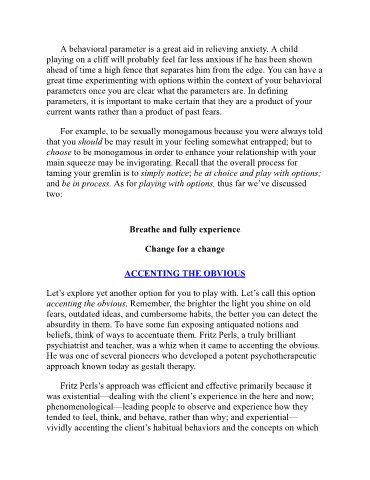Page 117 - Taming Your Gremlin A Surprisingly Simple Method for Getting Out of Your Own Way (Rick Carson)_Neat
P. 117
A behavioral parameter is a great aid in relieving anxiety. A child
playing on a cliff will probably feel far less anxious if he has been shown
ahead of time a high fence that separates him from the edge. You can have a
great time experimenting with options within the context of your behavioral
parameters once you are clear what the parameters are. In defining
parameters, it is important to make certain that they are a product of your
current wants rather than a product of past fears.
For example, to be sexually monogamous because you were always told
that you should be may result in your feeling somewhat entrapped; but to
choose to be monogamous in order to enhance your relationship with your
main squeeze may be invigorating. Recall that the overall process for
taming your gremlin is to simply notice; be at choice and play with options;
and be in process. As for playing with options, thus far we’ve discussed
two:
Breathe and fully experience
Change for a change
ACCENTING THE OBVIOUS
Let’s explore yet another option for you to play with. Let’s call this option
accenting the obvious. Remember, the brighter the light you shine on old
fears, outdated ideas, and cumbersome habits, the better you can detect the
absurdity in them. To have some fun exposing antiquated notions and
beliefs, think of ways to accentuate them. Fritz Perls, a truly brilliant
psychiatrist and teacher, was a whiz when it came to accenting the obvious.
He was one of several pioneers who developed a potent psychotherapeutic
approach known today as gestalt therapy.
Fritz Perls’s approach was efficient and effective primarily because it
was existential—dealing with the client’s experience in the here and now;
phenomenological—leading people to observe and experience how they
tended to feel, think, and behave, rather than why; and experiential—
vividly accenting the client’s habitual behaviors and the concepts on which

